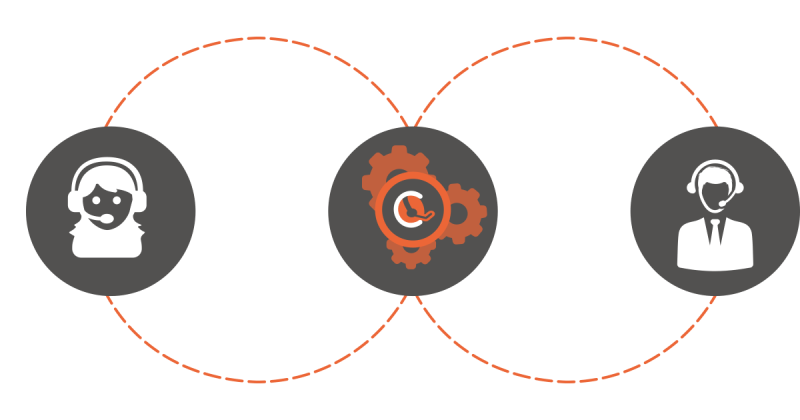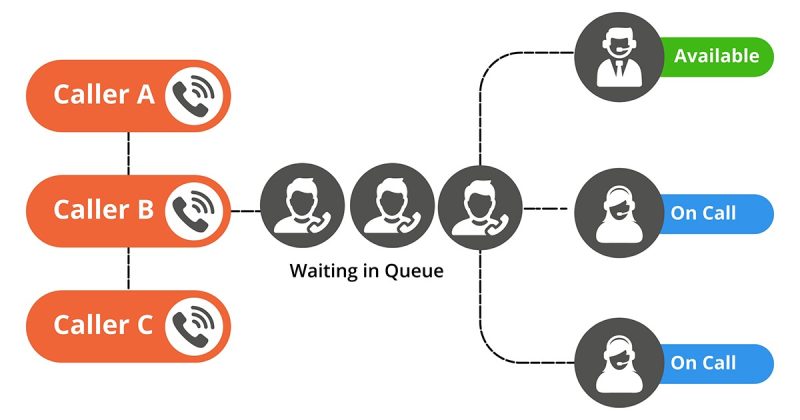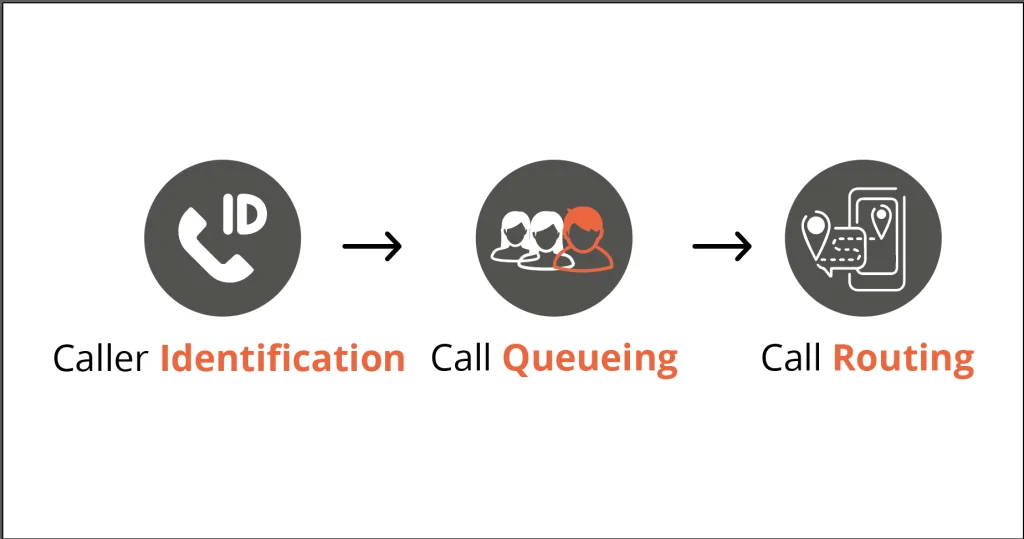What is ACD (Automatic Call Distribution) and Its Importance – HoduSoft
In today’s time, all the well-performing Contact Center Software has ACD as one of its primary components. Automatic Call Distribution (ACD) makes the communication process smooth and easier.
A call center is a place where the agents have to deal with a lot of callers daily. To maintain their productivity and high morale, it is vital to offer them all the essential call center tools. ACD is the most important and necessary tool that can help agents in the smooth handling of calls.
What is ACD?
“ACD stands for Automatic Call Distribution, is a telephony system that answers and distributes incoming calls to a particular department or agent within an organization.“

ACD- The Best Telephony System to Keep Your Agents Stay On Top of Things
The system usually directs calls based on the following factors:
- Customer’s selection (IVR)
- Telephone number
- The selected campaign
- Time of the day, etc.
The purpose of implementing an ACD phone system is to sort and manage large volumes of calls. This also helps to avoid overburdening the agents. The system is not only beneficial for the agents but also the customers. How? Well, with the help of automatic call distribution software, callers can reach the most appropriate agent in the least possible time. This not only increases customer satisfaction levels but also enhances customer experiences.
The automated call distribution software usually works with:
- Computer Telephony Integration (CTI) systems
- Interactive Voice Response (IVR) systems
These systems intelligently direct the incoming calls to the specific agent or department. Sometimes, people get confused between IVR and ACD. But, both the terms are different from each other.
Related Read:
How You Can Deliver Great Customer Experience With Smart ACD
Difference between ACD and IVR
Though Automatic Call Distribution (ACD) and Interactive Voice Response (IVR) systems aren’t the same, they work magically when used together. Most call centers these days use an inbound automatic call distribution system. They use it together with an IVR system to manage incoming calls and route them to a particular agent/department. Both these advanced VoIP features-
- Helps to route callers to the correct extension
- Cut down on wait times and call transfers
- Prevent human interaction
As mentioned above in the blog, ACD systems receive inbound calls and route callers to the most appropriate agents. After understanding the caller’s needs, the software distributes the calls to agents according to skills-based routing and task prioritization.
Now, let’s talk about the IVR system. An IVR system allows callers to interact with voice prompts or dial-pad inputs to navigate menus. Using this system, users can make payments or get self-service by providing their name and other essential details. Most IVR systems provide company information like business hours, location, and others. If the customer is not satisfied with the self-help, the IVR system can route the caller to a department or agent with the help of ACD technology.
Let’s learn more about IVR and ACD, Different.
- When a customer reaches customer care via phone, the first interaction they have is from an IVR system. The system offers them various options to choose from. Sometimes the self-help using the IVR system is enough for the callers. They don’t feel the need to speak to a live agent. Yet, if the need arises, the role of the ACD system comes into the picture.
- When a caller doesn’t get a satisfactory solution for his/her concern, they are usually directed to a live agent. The ACD system is responsible for directing the callers to the appropriate agent or department. However, where exactly the system directs them completely depends on the options selected by the customer during the IVR interaction. A well-configured IVR system can gather all the essential data to inform ACD software on how to assist callers.
How does ACD work?

When the system receives a call, the caller gets a greeting message (recording) and is presented with an IVR menu. This IVR system collects all the important information about the caller. It asks the callers to select an option from the menu to determine their purpose for calling. If the caller likes to connect with a live agent, the IVR system passes the required details to the ACD. The system then starts working in the below three steps:
- Caller Identification
- Call Queueing
- Call Routing
Let’s explore all these steps in detail:
Caller identification
The first step that the ACD system considers is going through all the key details related to caller ID. The details may include the caller’s purpose, language, location, etc. Based on these details, the ACD directs the caller to an agent that is best equipped to handle their concern..
Call Queueing
Call queueing is another important step that includes sorting the callers into a waiting list. The order of the queue is usually determined by the distribution system based on the following factors:
- Status: Call centers can place their callers in a queue and prioritize them before connecting them to an agent. Generally, VIPs get prioritization over others.
- Waiting time: The users can distribute the callers to the available agents based on the time they are waiting to connect with an agent.
Type of query: Users can even program their system to direct callers based on their specific queries. This ensures that the most suitable agent is handling those queries in the minimum possible time.
Call Routing
The last but the most important step performed by ACD is call routing. Companies can program their automatic call distribution contact center to route calls based on their preferred distribution method.
Different types of distribution methods are available for the companies to choose from. It is vital to choose the one that works best for your business. Some of the most commonly-used distribution methods in call centers include:
Skills-based distribution
If you want the most appropriate agent to handle your customer, then you can choose the skill-based routing method. It means that users can route the calls to agents according to their qualifications as they relate to the caller’s issues. The skills-based distribution is largely influenced by the responses a customer provides in the IVR system. For example, the kind of support he/she requires (general or technical), preferred language, location, etc.
Time-based distribution
Generally, the companies that have remote employees working across multiple geographic locations and time zones prefer the time-based distribution method. Using this method, users can route the calls based on agent and caller time zones. Users can even schedule the calls as per available business hours. If no agents are available, users can direct all the inbound calls to voice mailboxes.
Fixed order distribution
Also known as the linear call distribution method, call centers can use fixed order to route the calls as per pre-scheduled agent order. For every inbound call, the list always begins with the agent who is first in the line to take calls. Another agent will only answer the call when the first agent is busy.
Idle time distribution
Users can route the calls based on the agent who is sitting idle for a long time, meaning who has not taken any calls. This method helps in distributing the workload evenly among the agents and prevents them from getting overburdened by calls. Management can also allow each agent to put their best and show their skills by distributing the calls evenly.
Simultaneous distribution
Call centers that work with an intent to reduce customer wait time, usually consider the simultaneous call distribution method. Under this method, users can distribute all the inbound calls among the available agents within a group. As soon as the first agent answers the call, the other available agents within the group start receiving the next inbound call simultaneously.
Rotary call distribution
Call centers that want to distribute an equal volume of workload among their agents usually prefer the rotary call distribution method. Under this method, all the agents get equal turns in answering the incoming calls. Once everyone has taken the chance to answer the call, the cycle then repeats from the first agent.
Benefits of ACD phone system and Who all can benefit from using it?
All the call/contact centers as well as businesses that deal with high volumes of calls can benefit the most from the ACD. Even businesses with small call volumes can benefit from an ACD system. Especially, if they have a team working across different locations. Now, let’s look at some of the key benefits of ACD for businesses:
Better productivity
Automatic Call Distribution connects customers to agents who are well equipped to handle the customer’s concerns effectively. This means those who have the right skills and knowledge related to the concerned topic. This allows agents to provide the best solutions to customers in a fast and efficient manner. This way ADC helps in improving the productivity of agents.
Improved workforce management
ACD allows organizations to route calls properly and systematically. It ensures that all the agents get an equal volume of calls, thus reducing the agent’s idle time. This way it assures improved workforce management.
Enhanced customer experience
Smart and intelligent call routing allow customers to connect with the most appropriate agent who can handle their concern in the best possible manner. This means they can get the best solution for their concern. Besides, the fast distribution reduces the customer wait time and results in increased satisfaction levels.
Reduced costs
With the help of the Automatic Call Distribution system, the overall costs of transferring calls reduce greatly. Moreover, the first call resolution helps in cutting down the need for multiple call transfers.
Cloud-based systems
ACD works on a cloud-based system. Therefore, it doesn’t require the installation of hardware or software. Businesses that have a stable internet connection can use ACD, regardless of their location.
Easier collaborations
ACD system offers smooth collaborations between different departments and agents within the company. It comes with assorted features like videoconferencing, listening, whispering, teleconferencing, and more. All these features allow another agent or senior-level person to smoothly transition into an ongoing call if required.
Related Read: The Need and Importance of Automatic Call Distribution System in Call Centers
These are just a few benefits of an automatic call distribution system. If also we offer custom features as per your needs in your contact center software.




